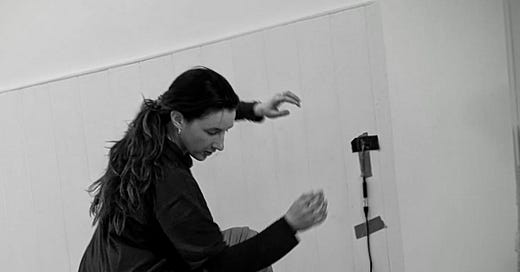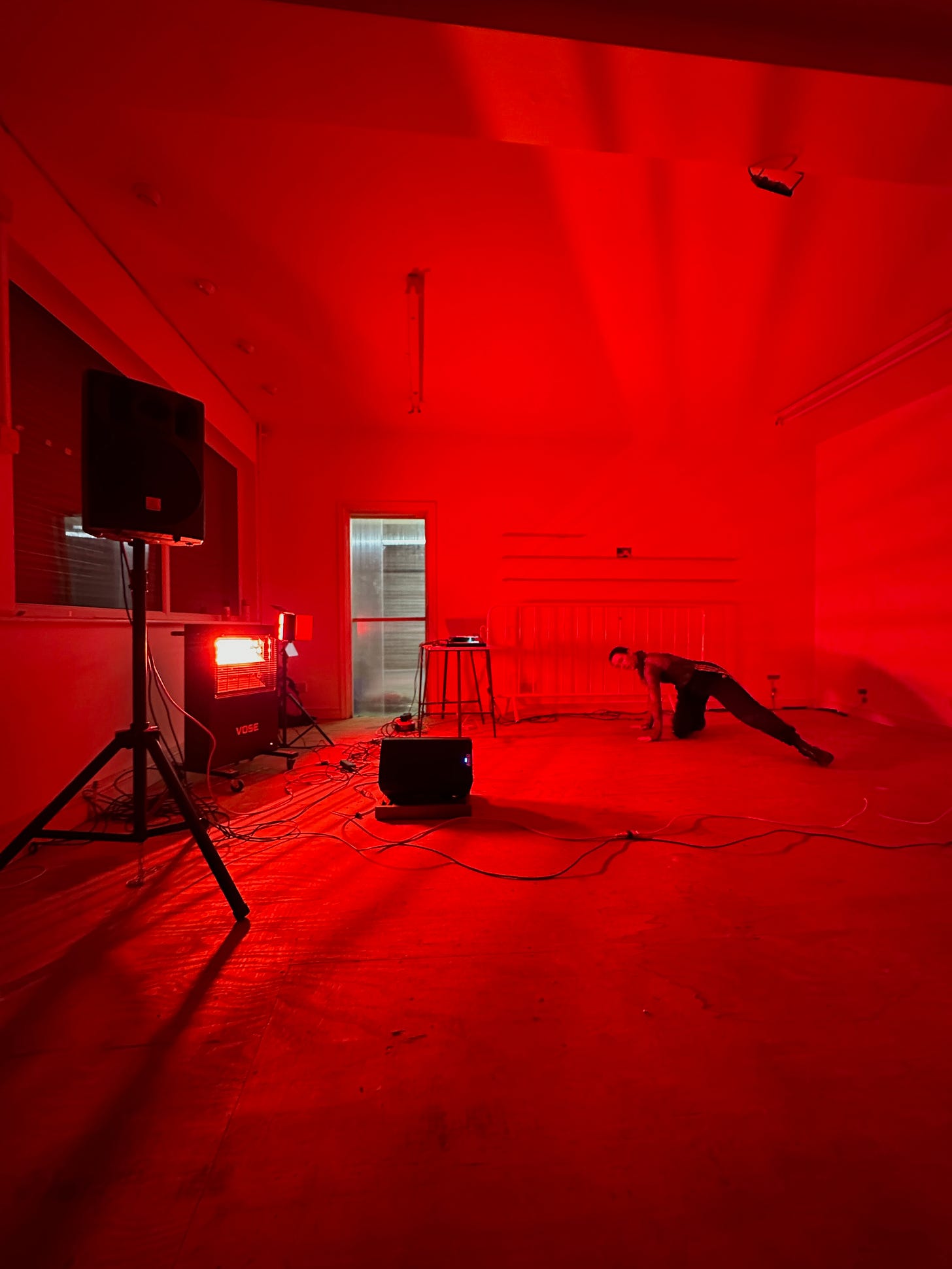"How could the movement of my whole body turn into sound, somehow?"
An Interview with Ashling McCann, AKA Shlinga, on her journey into sound-based performance.
A trail of wires, taped to the floor, running horizontally along the edges of a wide staircase. One wire trails along the edge of the floor, up a wall. Another extends, tendril-like, onto the dance floor itself. The empty space, surrounded by curious audience, is soon transformed not only by the playful sliding, skipping, and swooping of Ashling’s movement, but also by a cacophony of sound.
The wires each end in tiny microphones, which pick up the vibrations of Ashling’s motion; every sweeping arm and stamping foot, to be transformed through technology into music. Sound artist Rob Griffiths is in command over a laptop, a keen eye still on the movement, helping to mould the organic sounds into a multi-layered soundscape to which Ashling then responds in turn, her movements growing more indulgent and full-bodied. It is a call and response with the space, Ashling’s dance both creating, and responding to, the noise. The audience spills across two floors of Dance City’s open central space, with viewers peering over balconies and lining the stairwell, transfixed by the duet of body and sound.
Dance Edits, on 2nd October, was my second time seeing Ashling’s work, the first being at PLATFORuM scratch night hosted by DANE earlier this year. On that occasion, the piece was playfully placed in a corner, alongside a ballet barre and bicycle wheel, the metal spokes and echoing wall offering their unique sonic qualities to the score.
I wanted to delve into Ashling’s creative journey, to discover where these ideas have come from, and what she has planned for the future. Keep reading to find out about her inspirations in sound-based art, and where you can see her perform next.
What first drew your interest into working with Sound?
I think it probably kicked off after moving to Newcastle, and I found myself befriending many musicians - shout out musician friends! I always loved listening to music, but I think until then I hadn't seen loads of live music, to be honest. So I would go along to my mates’ gigs and shows, and I always loved watching the bands play. I always found it so fascinating seeing what or how the different musicians were moving, in order to play their instruments; what was physically required to get those sounds out.
So, I found that visual aspect really interesting. And I guess I also found myself working in collaboration with musicians in some improvisation settings, which was very new, but very fun and experimental. This kind of, blowing the doors off your creativity type thing, that was freer than anything I'd done before. Working with other dancers and musicians was a very interesting thing that led to all this; I always really liked getting together to just jam. Newcastle is great in that it's a small enough community to just get musicians and dancers together, to get them in a room, play some warm up games, and then have live jams in open spaces, where everyone is kind of vibing off each other.
I always found that so interesting, seeing how people interact, how people move through space, and the spontaneity of that. Watching people express themselves, and be themselves using their art form, whether it's mostly their body moving or sound moving through their instrument. It's so fascinating to get to know someone through how they express themselves spontaneously, in a live jam; I think you just see so much of who a person is when they're improvising. I find it really, really beautiful to watch.
So there were all these different influences, and I was fascinated by seeing sound happen. Like I mentioned, watching those gigs, and thinking about how every sound that is created, is created by some kind of movement. So if you're stepping along a creaky floor, that floor is creaking because you're stepping on it. And I think from there, I was like, “Huh, wait a minute, I move all the time as a dancer, so how could I stretch this idea out? How could I really play with it, and how could the movement of my whole body turn into sound somehow?”
I don't really remember when I was first introduced to contact microphones, but they got in there somehow. At some point, I started attaching microphones to surfaces, and playing with how I could move on those surfaces, and it all kicked off from there really.
Image by Alexandra Robertson.
What have been the most influential experiences within the project so far?
I have been influenced, and very much encouraged by, some very generous and lovely friends, who took the time to show me how I could put some ideas into practice. Some of them even taught me really useful things, which have enabled me to get this performance to where it is now - shout out to Rob Griffiths, who I collaborated with in Dance Edits. Rob showed me the ropes of Ableton, which is a sound software program which I use to create different sounds that eventually happen when I interact with the microphones. So, a lot of people have been very generous, and kind with their time to explore this with me.
I would also say that concentrated time has been very useful. I took part in the winter residency at the Old School Gallery in Alnmouth, which was lovely, I got to stay in a beautiful beachside Airbnb (the dream) and I had a week to focus on getting to grips with Ableton and the sound software side of things. It was really, really beneficial to have that week in a different place, and just to get myself up to speed with how I could do this as a solo show. How could I experiment with where I'm putting these microphones in a room, what kind of sounds I'm interested in creating, from what movements? Having that long time to try things, mess things up, be really frustrated that things weren't working, you know the drill - that was a really, really useful time.
And then, off the back of that, Steve from Industrial Coast got in touch after seeing something online, to offer me a gig in Middlesbrough. Industrial Coast hold gigs out of the Auxiliary that are quite experimental, a lot of noise/experimental sound work, as well as visual, film and sound related things. That was just really lovely that they offered me that first gig, and just said “Come and do your thing.” And I was nervous! I was like, “Oh my gosh, okay, here we go. My first solo gig of this.” But it was great to give it a first run, and to realise that this idea resonated with people, and that the audience were so lovely and warm. It really felt like it landed, and like it had legs to continue.
More about Industrial Coast here:
https://industrialcoast.bigcartel.com
Finally in terms of research, I recently got the chance to go and see Sonica, which is a brilliant sound and art festival up in Glasgow. I got the chance to run around it for two days and see as much as I could; gigs, installations, performances, artist talks, workshops… It was such a treat to be around so much incredible art. Some of the installations were just so clever, but also really beautiful to be around. Floris Vanhoof from Belgium had this installation, Antenna, where a piano was on its side, and you can't really play a piano on its side because gravity won't let you. So he made an antenna that intercepted the various electromagnetic waves in the room, phone signals, radio signals, all these kinds of things, and he made it so that those signals could play the piano. It blew my mind.
I also really loved seeing Martin Messier’s work, 1 Drop 1000 years, a really brilliant performance with water and light. He was dropping water from various points on the ceiling, and playing with different kinds of light that mess with your eyes, with an incredible sound score that was very mesmeric. There are various things like this that you see, just really brilliant creators, expressing their creativity using sound in really inspiring ways. I think his work is really impactful. And, something I took away from his talk was that he said that we can explain our work away. It's great to explain the rhyme and reason sometimes, but he also said, “Just let the work speak for itself.” So the work itself has got to be clear enough that it makes sense to the audience.
I think that's something I've already found in doing this. I have explained the idea to people, like, I'm attaching microphones to a wall, moving on the wall, and people are like, “Alright, good luck with that.” But I've also found that people will say, “Oh, I didn't get it until I saw it.” And that's been a really lovely thing I’ve been exploring this past year that I've been doing this gig, it's so lovely to just show people what you're on about and see how it lands.
Sonica, Antenna, and 1 Drop 1000 years:
https://sonic-a.co.uk
https://florisvanhoof.com/Antenna
https://martinmessier.art/1-drop-1000-years.html
Image by Calum Dyer.
What are your aims and aspirations for the work? What is your dream?
I would love to continue performing it as a live thing. It's just really lovely to connect with audiences in this way, showing them a fun idea I've had, that’s turned into a thing I can perform. I really enjoy performing it. But, I would also love to continue expanding the scale of it. I'd love it to grow, and an aspect of it that I really want to create space for, is to let people have a go themselves.
So in all my gigs, I tend to leave the microphones on in the space afterwards and just invite the audience to have a go themselves, and try out some moves in the space. I find that as a dancer, a lot of people say “I can't dance. Oh, I just can't do that. I could never do that.” And it's not true! I don't think there's one way of moving, and I really hope this idea can encourage people to try moving. Just moving in a different way to normal, or in a playful way, or in a way you didn't realise you could. I think creating sounds is quite a nice, disarming way to encourage movement.
I would love to create a setup that I can demonstrate how to use, but then that also gives people the space to play themselves and have fun with movement. Like, moving is so fun. I really love getting to run up and down steps, and stamp on floors, and create sounds. I would love to let people into that, I don't want it to be an exclusive thing that I'm keeping at arms lengths from people. I want people to be able to have fun with it too. So that's kind of the dream.
How can people see/take part in your work next?
My next gig is on the 13th of November, at The Central Bar in Gateshead. That is run by Invisible City Records, aka Craig Johnson, (shout out, Craig!) that's going to be a great night alongside some other brilliant artists with sound-based work.
So yeah, come and play! Come and slide on the floor and kick a wall.
You can follow Ashling on instagram @shlinga_makes_sounds to keep updated with future gigs and other exciting developments.






A fascinating article Pagan. This artist seems to be at the forefront of combining sound and movement and vision, in a new and exciting way. How do you get up so early and produce work like this? Dave S.